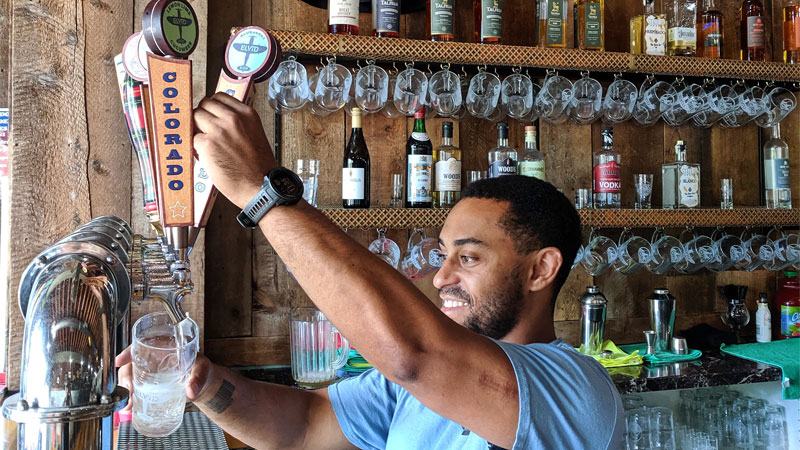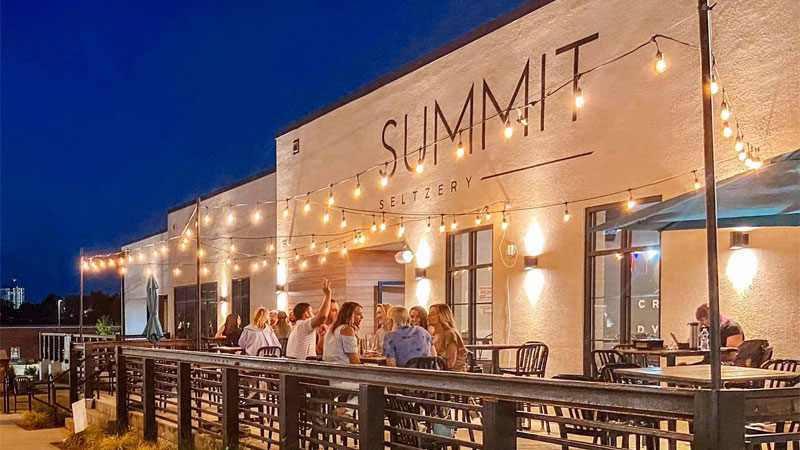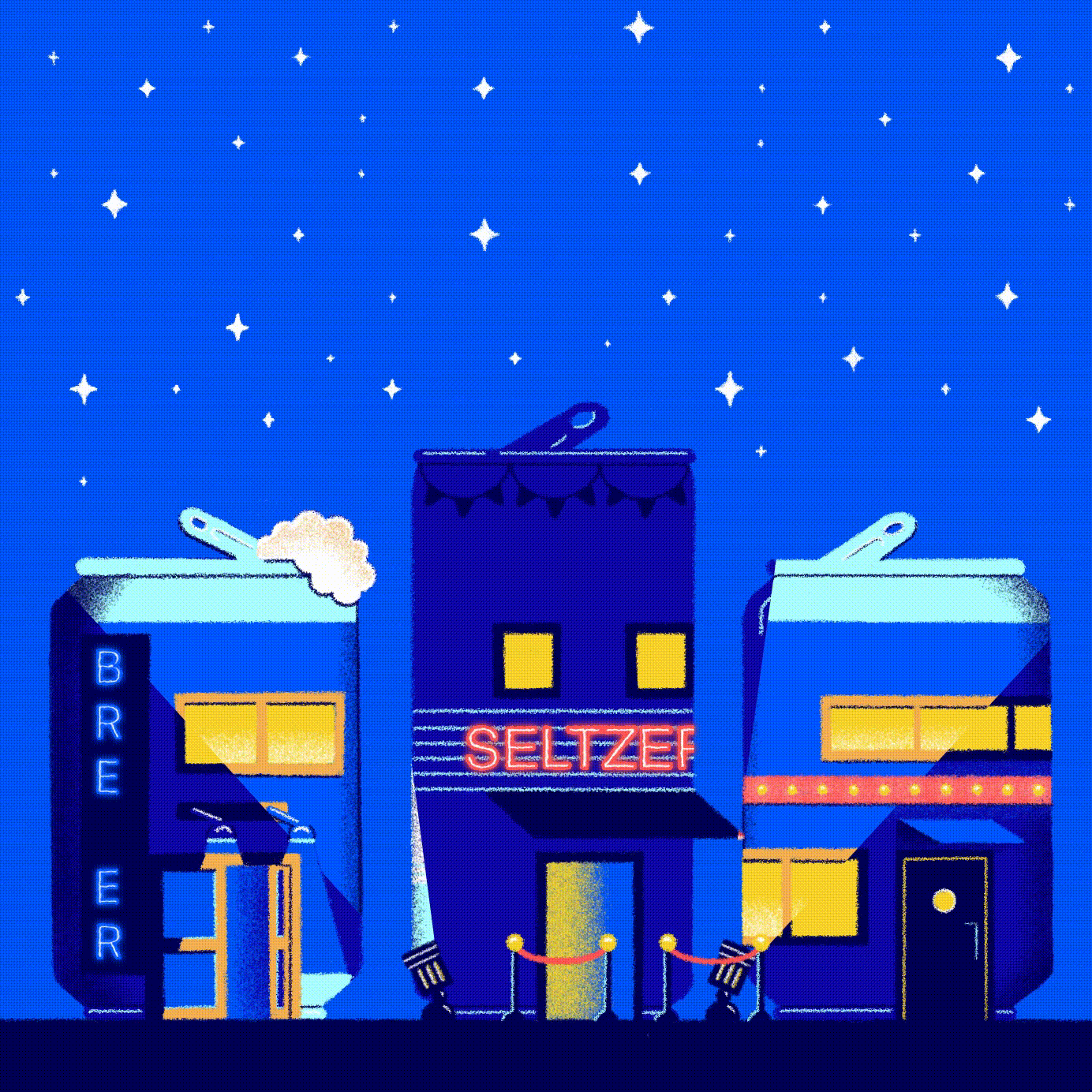This month, VinePair is exploring how drinks pros are taking on old trends with modern innovations. In Old Skills, New Tricks, we examine contemporary approaches to classic cocktails and clever techniques behind the bar — plus convention-breaking practices in wine, beer, whiskey, and more.
Don’t listen to the recent death knells ringing out for hard seltzer. Not only has the category’s market share exploded in five years what it took craft beer to do in 40, but much like when brewpubs started to emerge in the macro-brew- dominated 1990s, small seltzer-focused taprooms are starting to spring up around the nation.
These spots go beyond the slim-line cans and the standard White Claw flavors, too. Much like craft breweries, if you want to see where the innovation in seltzer is happening, head to one of the very few hard seltzer taprooms, not for the stacks of mixed 12’ers at the grocery store.
Outside of the White Claw world of Mark Anthony alcopops, nearly all of seltzer’s developments are coming from the world of craft breweries. Yes, Boston Beer is basically a Truly machine at this point. But in a world where thousands of brewery taprooms have experimented with a hard seltzer by now (if some only begrudgingly), it’s perhaps not surprising to learn that it took former craft beer lovers to come up with all-seltzer spaces. And if you’re searching for an innovative new drinking experience, these seltzer pioneers are your best bets.

Arvada, Colo.’s Elevated Seltzer opened its doors in July 2019 with Warren Wood and his brother Hunter at the helm. The Woods grew up in the brewing world, as their parents started Grand Lake Brewing Co. when Warren was 10 years old. After watching the explosion of craft breweries throughout Colorado, you can thank the increasing corporatization of those operations for Warren’s pivot to seltzer.
“We’ve been in the industry for so long that we’ve really seen it take a different turn than what we really loved about it. When we started up, it was my parents’ brewery and maybe like 25 others in the state,” Wood says. “It was a small craft community, everybody was super cool with each other. And now it’s turned into more of like…a business.”
Wood didn’t see a space in the market for the straightforward, untrendy beers like nut browns and lagers that they originally wanted to produce. ”We like to make straight-up beer. We don’t want to do the lactose sours and the double triple hazy IPA stuff,” he says. “It’s not where our passion comes from. And the fact of the matter is there wasn’t a place in the market for us.”
Enter: seltzer. The Woods were actually in the process of building out their own brewery when they decided to pivot fully into seltzer, a move that they expected wouldn’t be a popular one in the brewing community. “In the brewing industry at the time, like two years ago, if a brewery made a seltzer, you’re the devil, you know?” Woods says. “You went against everything that you believed in. [And] we were just like, let’s do it.”
It’s worked out so far. Elevated’s taproom currently offers nearly 20 seltzers (in 5 percent and 7.5 percent ABV) and seltzer cocktails alongside a small selection of beer and wine. Don’t expect to see just the standard mango, lime, and mixed berry flavors, though. “We don’t have to risk putting 2,500 cans of a small-batch thing out on the market. We can make one keg of it if we want and put it on draft,” Wood says.
Experiments like that led to a recent gin-barrel-aged blackberry elderflower seltzer release, and a Valentine’s Day special chocolate-strawberry seltzer packaged into 22-ounce bombers and sealed with red wax. As Wood puts it, “That’s the power of the taproom, to be able to experiment without the risk.”
In Seattle, San Juan Seltzery opened its taproom doors in September 2019, though the brand itself dates back to 2017, when a weekend getaway drinking huckleberry vodka sodas among friends turned into its own seltzer brand for founder Katy Enger. Her company now also boasts wine-flavored seltzers, cocktail-inspired seltzers and hard lemonade seltzers.
CEO Ron Lloyd, whose experience in beverages through the years runs from Capri-Sun and kombucha to wine and now to seltzer, says the taproom is not just a place to sip a seltzer; it’s a San Juan Seltzer experience. “This is really brand-focused. This is not a restaurant. This is not a full-service bar,” Lloyd says. “This is a taproom, and it is focused on San Juan Seltzer, being a seltzery, selling our story, talking about Katy’s vision, talking about our new unique flavors, and really leveraging one of our many firsts: first to be zero sugar, zero carb, first seltzer brand from the Pacific Northwest, and the first to introduce our product on draft.”
They also see the taproom as a way to test new ideas. “It really [is] a great place for us to not only showcase who we are and what we stand for, but it becomes the testing ground for new flavors, to see what consumers want,” Lloyd says. “Every one of our new flavors has gone through our taproom, and you can tell what’s really hot.”
Their 15 flavors on tap focus on ingredients from the Pacific Northwest, from the huckleberry that originally inspired the brand, to Rainier cherries, Fuji apples from a nearby orchard, and pears from Oregon (for a seltzer VinePair named among the best to drink last fall). Basically, if they can’t grow it locally, you won’t find it on their menu. “We can’t do a mango or a pineapple because those don’t grow here,” Lloyd says.
San Juan is also the only “seltzery” on this list because it managed to snag the trademark on the term. Yes, in a world full of breweries, distilleries, and wineries, there’s but one “true” seltzery on the continent and it’s San Juan — at least until someone wants to let their lawyers fight that out in court.

Another recent entry to the taproom seltzer space is Charlotte, N.C.’s Summit Seltzer, opened in September 2020. Founder/owner Kristin Cagney spent a decade in the craft beer business before leaping onto the seltzer side of things. “I really had a passion for craft beer,” she says, “and when I saw this craze for seltzer I [said] what if we opened up a taproom, and really just focused on inviting people in to try all kinds of different seltzers at the same time and really explore the craft side of it?”
The opportunity to innovate in an industry that’s in its infancy was also a big appeal for Cagney. “Some beers have been around for 400 years. We’re never gonna compete with the craft aspect of the history of beer,” she says. “I don’t think that it’d be fair to even try and do that because there is just so much historical meaning to it.”
Seltzer, though? There are no “styles,” no rules just yet: “A lot of people think it’s for, you know, young girls or frat bros, but there is a craft side to it that we want to explore,” Cagney says. Summit has seltzers in a range of strengths from 4.2 percent to 7.5 percent ABV and a dozen flavors including a dry-hopped tropical fruit seltzer and an acai-blueberry-raspberry seltzer. It’s also creating cocktails using its 14.5 percent ABV seltzer base for things like a jalapeño Margarita seltzer cocktail and a riff on the kiddie classic called a “Shirley Seltzer.”
Though most of its sales are on the seltzer side of the menu, there are a few beers on the list, and true to the small-craft nature of Summit, Cagney still has nothing but love for her industry peers. “I got into this industry because I love beer,” she says. “Beer and breweries and all the amazing brewers; they’ve paved the way for the seltzery to even open, so I want to definitely give my appreciation to the brewing culture.”
What’s next? Most recently an all-seltzer taproom temporarily popped up in a Chicago hotel and a pair of Kentucky brothers and nascent seltzer barons announced plans to open The Local Seltzery in Louisville, telling Louisville Business First their new process would include a proprietary seltzer “gun” for their taproom-exclusive seltzers this fall.
Seltzer taprooms aren’t quite taking over the world just yet. But don’t underestimate them, either. As the seltzer market matures and draft seltzer expands its reach, it may be only a matter of time before your neighborhood taproom is working with a lot less grain and a lot more fermentable sugar.
